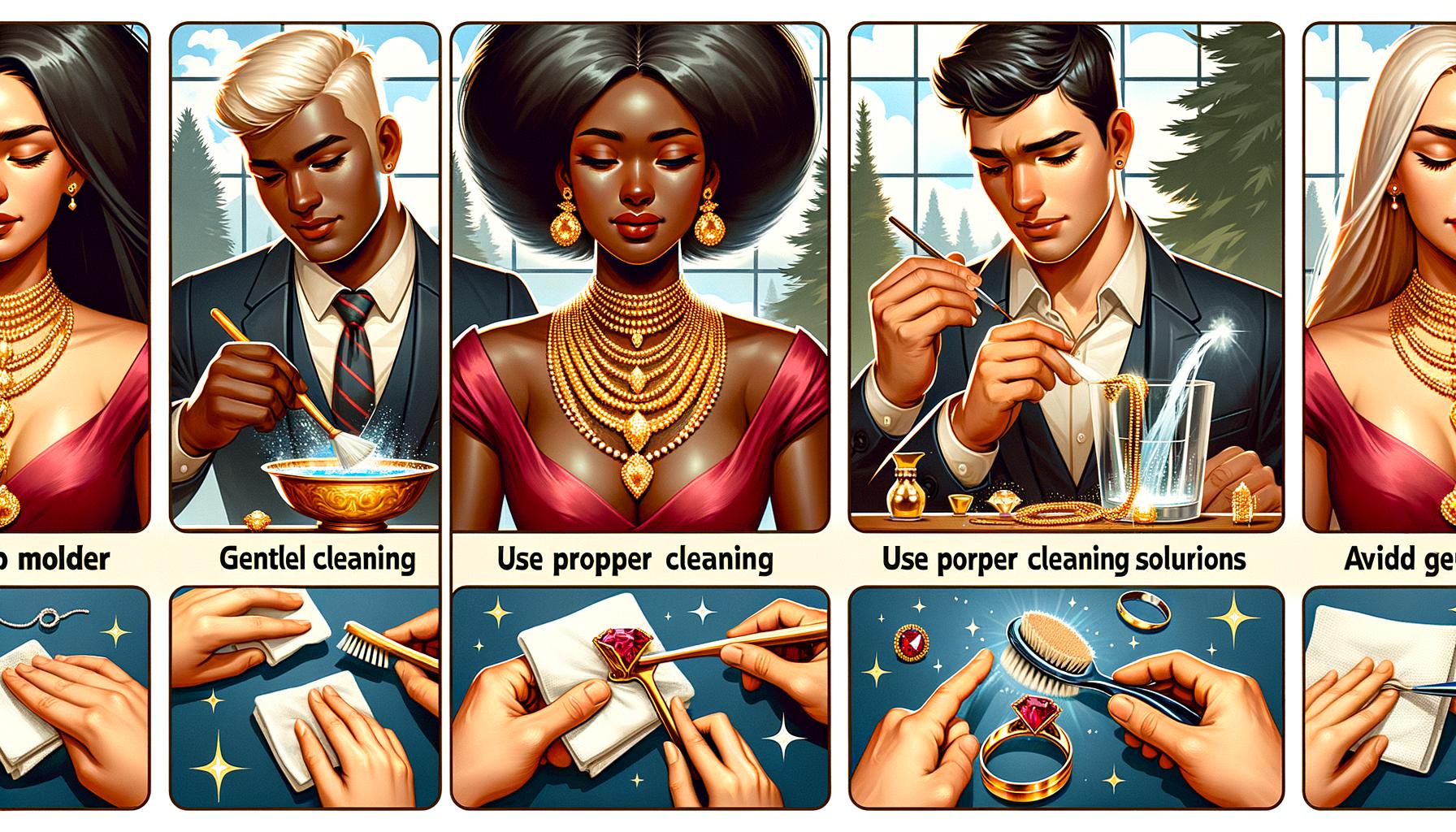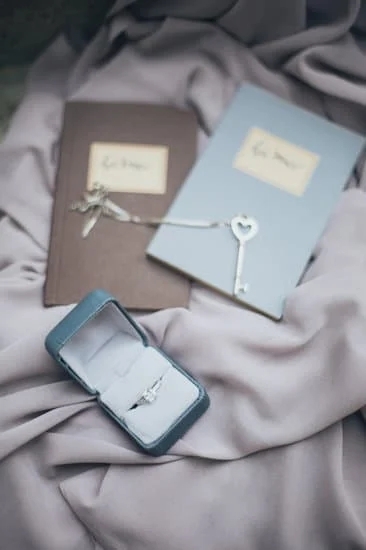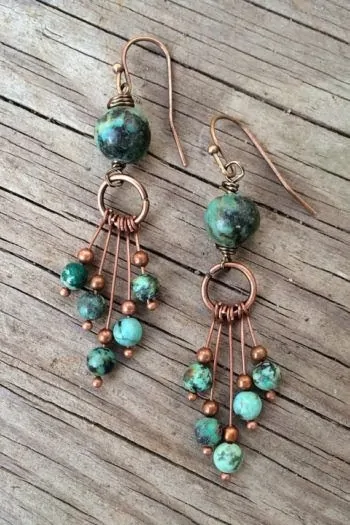Jewelry is more than just an accessory; it embodies memories, milestones, and sentiments. As such, keeping it in pristine condition is essential not only for its visual appeal but also for its longevity. Avoiding common mistakes when cleaning jewelry is crucial to preserving both the aesthetic and monetary value of your cherished pieces. Whether it’s a family heirloom or a trendy statement piece, proper care can make all the difference.
Proper jewelry cleaning goes beyond just making your gems sparkle; it’s about maintaining their structural integrity. Over time, dirt, oils, and everyday wear can cause buildup that dulls the appearance of metals and stones alike. However, improper cleaning techniques can lead to unintended damage, diminishing the beauty and longevity of your treasured items. Hence, understanding how to clean your jewelry correctly is indispensable.
From knowing the specific care requirements for various materials like gold, silver, platinum, gemstones, and pearls to choosing safe cleaning solutions over harsh chemicals-each step in the process matters greatly. Moreover, even practices that seem benign at first glance can be harmful if done excessively or incorrectly. Being informed about these practices helps ensure that you’re making decisions that will keep your jewelry looking as exquisite as the day you got it.
Understanding Your Jewelry
Maintaining the brilliance and luster of your jewelry begins with understanding the composition of each piece. Different materials such as gold, silver, platinum, gemstones, and pearls all have unique properties and require specific care methods to avoid damage. By learning about these differences, you can ensure that your cleaning techniques are suitable for the type of jewelry you own, ultimately helping in avoiding common mistakes when cleaning jewelry.
Recognizing Metal Types
Gold is a popular choice thanks to its timeless appearance and hypoallergenic properties. However, it’s essential to be aware that pure gold is quite soft and often alloyed with other metals to enhance its durability. Clean your gold pieces gently using a mild soap solution without scrubbing too hard to preserve their shine.
Silver jewelry, while beautiful and versatile, tends to tarnish over time due to exposure to air and moisture. Cleaning silver requires gentle polishes or specially formulated silver cleaners; aggressive polishing can easily scratch the metal.
Platinum is famed for its resilience and weighty feel but still demands careful maintenance. Platinum resists tarnish more effectively than silver but can still suffer from scratches if cleaned too abrasively. For platinum pieces, non-abrasive cleansers are recommended along with soft cloths to maintain their pristine condition.
Caring for Gemstones and Pearls
Gemstones such as diamonds, rubies, emeralds, and sapphires each require individual care protocols tailored to their hardness and setting type. For example, while diamonds are incredibly tough and scratch-resistant, they can collect oils from skin contact which dull their brilliance; use solutions specifically designed for diamond cleaning or mild soapy water paired with gentle brushing. Softer stones like opals or emeralds need extra caution-harsh chemicals or ultrasonic cleaners can cause irreparable harm.
Pearls represent one of the most delicate types of jewelry materials due to their organic origins-their nacre (outer layer) can be very sensitive. Always use mild detergent mixed with water on a soft cloth when cleaning pearls; never soak them in water as it might weaken their structure. Knowing how delicate pearls need special storage considerations will help you protect them from scratching by harder gemstones in your collection.
By gaining a comprehensive understanding of your jewelry materials’ distinct characteristics and appropriate cleaning methods tailored for each one, you’ll mitigate risks associated with improper care-making avoiding common mistakes when cleaning jewelry much simpler.
Common Mistake #1
When it comes to jewelry cleaning, many individuals mistakenly reach for common household chemicals like bleach, ammonia, or acetone. While these substances are effective for various cleaning purposes around the home, they can cause significant damage to your precious items. Harsh chemicals may strip the metal of its luster, weaken prongs and settings, and even discolor gemstones. This is particularly critical when handling delicate pieces such as pearls or opals that are highly susceptible to chemical damage.
Safe Alternatives for Jewelry Cleaning
For safer cleaning methods, opt for solutions specifically designed for jewelry care. Mild dish soap mixed with warm water can be an excellent alternative for most types of jewelry. Immerse your pieces in this mild solution and use a soft brush to gently remove dirt and grime. For more stubborn residues, consider purchasing commercial jewelry cleaners that are formulated without harsh chemicals. Always check the label to ensure they are safe for the specific materials you wish to clean.
Avoiding Damage With Proper Techniques
Apart from avoiding common mistakes when cleaning jewelry by steering clear of harsh chemicals, employing proper techniques is equally essential. When using any cleaning solution-whether homemade or commercially bought-always follow the instructions carefully. Never soak your jewelry longer than advised and avoid rinsing with hot water which can cause rapid temperature changes leading to material stress cracks.
Remember that each type of jewelry material has unique requirements; therefore, understanding these nuances can prevent irreversible damage and maintain their brilliance and integrity over time.
Common Mistake #2
Many jewelry enthusiasts mistakenly believe that frequent cleaning will always keep their pieces looking brand new. However, overcleaning can actually do more harm than good. Jewelry, particularly those with delicate settings or intricate designs, can suffer from excessive exposure to cleaning solutions and repetitive handling. This constant abrasive action can gradually wear down metal settings and dull the shine of gemstones.
Overcleaning can also negatively impact certain materials such as gold or silver. For example, gold is a relatively soft metal and can become thinner and lose its luster with too much polishing. Similarly, silver jewelry treated with specialized finishes may deteriorate if exposed to cleaners too often. To avoid these common mistakes when cleaning jewelry, it’s important to understand that sometimes less is more.
To maintain your jewelry without the risk of overcleaning, it’s essential to adhere to a recommended cleaning schedule based on the type of piece you own:
1. For Diamond Rings: Clean once every two weeks using a gentle solution.
2. For Gold and Platinum: A monthly polish is usually sufficient.
3. For Silver Pieces: Opt for bi-monthly cleanings unless tarnish becomes evident.
4. For Gemstone Jewelry: Depending on the stone’s hardness, clean every 1-3 months.
By following these guidelines, you ensure that your cherished items retain their beauty without unnecessary damage through overcleaning.
Common Mistake #3
Scrubbing your jewelry with abrasive materials might seem like a quick way to shine things up, but it can lead to significant damage. Items like toothpaste, baking soda, and household scrubs are too harsh for delicate finishes. They can create tiny scratches on metals and dull the sparkle of gemstones. While these methods may work for cleaning other household items, they’re not suitable for preserving the beauty and integrity of your precious pieces.
To clean your jewelry safely, opt for non-abrasive materials that are gentle yet effective. Here are some recommended tools:
- Microfiber cloths: These are excellent for wiping away smudges without scratching the surface.
- Soft-bristled brushes: Use these for detailed areas around stones and intricate designs where dirt can accumulate.
- Jewelry-specific cleaning solutions: These products are formulated to protect your jewelry while removing grime effectively.
It’s important not only to choose the right materials but also to handle them properly. Avoid using sharp objects like needles or pins to dislodge dirt from crevices as they can scratch surfaces or loosen settings. Instead, gently soak your jewelry if necessary and use appropriate cleaners designed specifically for each type of material. By avoiding common mistakes when cleaning jewelry, you ensure that every piece remains as dazzling as the day you got it.
Implementing safe practices in your jewelry maintenance routine can significantly extend the life of your precious items. This involves more than just steering clear of abrasive substances; it includes being mindful of how you handle each piece during cleaning sessions. Employing these carefully selected tools will keep your jewelry looking pristine without causing unintentional harm. Taking such precautions helps in preserving both the sentimental value and monetary worth of your cherished accessories.
Common Mistake #4
One of the most overlooked aspects of maintaining your jewelry is the value of professional cleaning. While many people may feel confident in their ability to clean their own pieces at home, it’s essential not to underestimate the expertise provided by a professional jeweler.
Professional cleaning services offer more than just a thorough cleanse; they also include detailed inspections that identify potential issues long before they could lead to significant problems. By avoiding common mistakes when cleaning jewelry at home and opting for periodic professional care, you can ensure that your cherished items remain in the best possible condition.
Professional jewelry cleanings usually involve advanced techniques and specialized equipment that are not available for consumer use. Ultrasonic cleaners, steam cleaners, and high-quality polishing compounds are examples of tools professionals utilize to remove dirt and grime from intricate settings without causing damage.
These methods are particularly effective in reaching areas that are difficult to clean with household tools, ensuring a deeper clean while preserving the integrity of your jewelry. This level of care can prevent unnecessary wear on settings and extends the lifespan of your pieces.
Additionally, during a professional cleaning session, jewelers often conduct detailed evaluations of each piece. A certified jeweler can spot loose stones, weakened prongs, or other vulnerabilities that might go unnoticed to an untrained eye.
Regular visits to a jeweler for professional cleaning and inspections enable these issues to be addressed promptly before they result in more severe damage or loss. Thus, investing in occasional professional cleanings complements your regular at-home maintenance routine and provides an extra layer of protection for your treasured possessions.
DIY Jewelry Cleaning
Cleaning your jewelry at home can be a convenient and cost-effective way to keep it shining, but it’s essential to follow safe practices to avoid any damage. Begin by identifying the type of jewelry you have; different materials require unique care routines. For example, gold and platinum are usually more resilient compared to softer metals like silver or copper, but they too can suffer from improper cleaning methods.
For a safe DIY approach, start with a simple solution of warm water and mild dish soap. Soak your pieces for several minutes before gently scrubbing with a soft-bristled toothbrush.
This method works particularly well for general grime removal on most types of metal and hard gemstones like diamonds, sapphires, and rubies. It’s important to note that avoiding common mistakes when cleaning jewelry involves steering clear of abrasive materials such as baking soda or toothpaste, which can scratch softer metals and stones.
When dealing with delicate items like pearls or porous gemstones such as opals and turquoise, exercise extreme caution. These materials should not be submerged in water; instead, wipe them carefully with a damp cloth and dry them immediately with a soft towel. Additionally, if you’re uncertain about the best cleaning methods for a particular piece or material, always err on the side of caution by seeking professional advice or using products specifically designed for jewelry care.
Storing Jewelry Properly to Reduce Cleaning Needs
Proper storage of jewelry is crucial not only for keeping your pieces organized but also for minimizing the need for frequent cleaning. One of the key aspects to consider when storing jewelry is to use anti-tarnish strips or bags, especially for silver items. These protection tools help absorb pollutants in the air that cause tarnishing, ensuring that your jewelry maintains its luster over time.
Another essential aspect of proper storage involves segregating each piece of jewelry. Tangling can cause scratches and damage delicate chains and settings. Use individual pouches, compartments in a jewelry box, or even small ziplock bags to keep each piece of jewelry separate. This practice can prevent the mechanical wear and tear that often necessitates more frequent cleanings.
Climate control also plays an important role in maintaining your jewelry’s condition. Moisture can accelerate tarnish and negatively impact certain gemstones like opals or pearls, which thrive in regulated environments with controlled humidity levels. Storing your pieces in a cool, dry place away from direct sunlight can significantly reduce these risks and prolong the intervals between necessary cleanings.
| Storage Tip | Benefit |
|---|---|
| Use Anti-Tarnish Strips | Minimizes tarnish on silver items |
| Individual Storage | Prevents tangling and scratching |
| Climate Control | Reduces moisture-related damage |
By adopting these storage practices, you are actively avoiding common mistakes when cleaning jewelry, ultimately ensuring their longevity and brilliance without excessive maintenance efforts.
Recognizing When Your Jewelry Needs More Than Cleaning
While regular cleaning keeps your jewelry sparkling and well-maintained, there are instances when a simple polish is insufficient. Recognizing these signs early on can prevent further damage and preserve the integrity of your valuables.
One of the first indicators that your jewelry needs more than just a cleaning is loose stones. Whether it’s a diamond in an engagement ring or a smaller gem in a bracelet, any movement within the setting signifies that maintenance is required to avoid losing valuable components.
Another symptom indicating the need for professional intervention is visible wear and tear. Check for dings, scratches, or worn prongs which may appear insignificant at first but can escalate into more severe problems if left unaddressed. Worn prongs are particularly dangerous as they can no longer securely hold a gemstone, increasing the risk of loss. Moreover, inspecting clasps and links regularly is crucial as weakened parts can cause bracelets and necklaces to break unexpectedly.
When examining pearls and other delicate stones, look out for surface blemishes or changes in color that might signify underlying issues. Pearls, in particular, are vulnerable to damage from improper cleaning techniques or storage conditions; hence identifying and addressing these problems early on are paramount. In some cases, recognizing that your jewelry needs comprehensive repair rather than simple cleaning involves understanding its emotional and financial value along with avoiding common mistakes when cleaning jewelry.
| Indicator | Possible Issue |
|---|---|
| Loose Stones | Potential loss of gemstones |
| Worn Prongs | Weakened hold on gems |
| Dings & Scratches | Nicks can lead to more severe damage over time |
| Tarnish & Discoloration on Pearls | Pearl degradation due to improper care or storage conditions |
Conclusion
Maintaining the brilliance and integrity of your jewelry is not just about keeping it clean, but also about doing so in a way that prevents damage and preserves its value. By understanding the common pitfalls, such as the misuse of harsh chemicals or overly aggressive cleaning techniques, you can ensure your treasured items remain beautiful for years to come.
Avoiding common mistakes when cleaning jewelry is crucial; it’s about striking a balance between keeping your pieces pristine and protecting their delicate structures.
Taking the time to learn about the specific care needs of different materials and stones can save you from unintentional damage. Each type of metal and gemstone has unique properties that require tailored approaches to cleaning and maintenance. For example, pearls are much softer than diamonds and need gentler handling.
Gold, silver, and platinum each respond differently to various cleaning agents. Overcleaning can be as detrimental as undercleaning, leading to worn finishes and loose settings if done too often with inappropriate materials.
Lastly, don’t underestimate the value of professional services for both routine maintenance and deeper inspections. Even with diligent at-home care, having a jeweler periodically examine your pieces can help catch issues like loose stones or worn prongs before they turn into costly repairs.
Proper storage also plays a significant role in reducing how often you need to clean your jewelry-using anti-tarnish strips, individual pouches or boxes, and keeping items in climate-controlled environments can prevent many common problems. By combining careful cleaning practices with regular professional check-ups, you’ll keep your jewelry sparkling while ensuring its longevity.
Frequently Asked Questions
What Not to Do When Cleaning Jewelry?
When cleaning jewelry, avoid using abrasive materials or harsh chemicals as they can scratch or damage the delicate surfaces of your pieces. Household cleaners like bleach, ammonia, or acetone are particularly harmful and should be kept away from your valuable ornaments.
Submerging jewelry in water for long periods can also be detrimental, especially for items with glued-in gemstones. Additionally, never use ultrasonic cleaners without checking if the specific piece is suitable for it, as the vibrations can loosen stones or cause other damage.
What Are the Tips for Jewelry Cleaning?
To keep your jewelry looking its best, use gentle cleaning methods tailored to each type of metal and gemstone. For most pieces, a mild soap solution and a soft brush will effectively remove dirt without causing damage. Ensure you thoroughly rinse and dry each item to prevent any moisture damage.
Store your jewelry in individual soft cloth pouches to avoid scratches and tangling when not wearing them. Regularly check for loose settings or worn parts that might need professional attention to ensure longevity.
Does Vinegar Damage Gold Jewelry?
Vinegar is generally considered safe for cleaning gold jewelry but should be used with caution and not for extended periods since prolonged exposure might affect certain finishes and adhesives used in some pieces. While vinegar helps remove grime and restore shine due to its acidic nature, it’s essential to dilute it properly and thoroughly rinse afterward to prevent any potential harm.
Ultimately, professional cleaning solutions specifically designed for gold are recommended to ensure that your jewelry remains in pristine condition without any risk of damage.

Welcome to my jewelry blog! My name is Sarah and I am the owner of this blog.
I love making jewelry and sharing my creations with others.
So whether you’re someone who loves wearing jewelry yourself or simply enjoys learning about it, be sure to check out my blog for insightful posts on everything related to this exciting topic!





